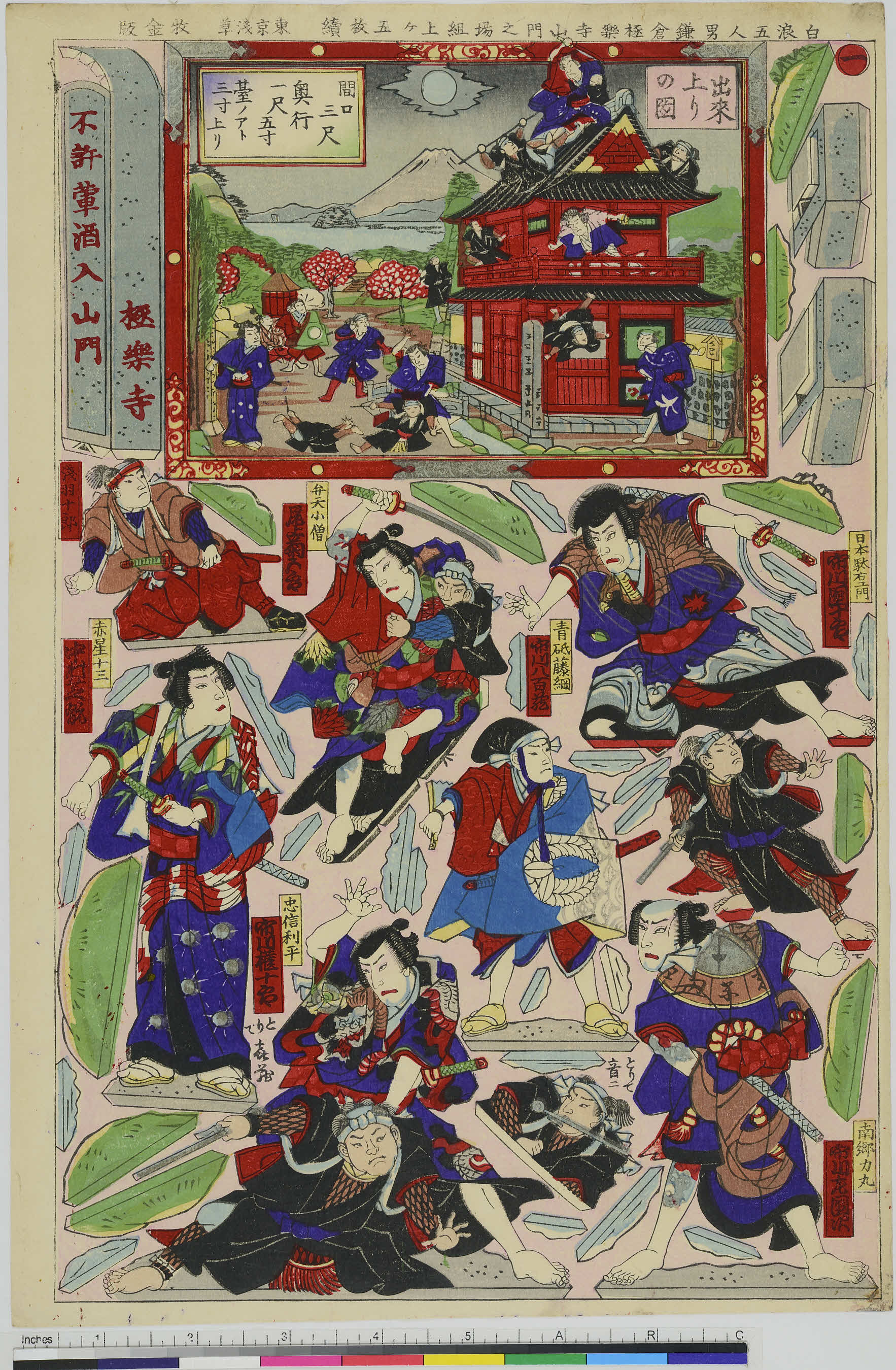G12 Kumiage-e
-
"Shiranami Gonin-otoko Kamakura Gokuraku-ji Sanmon-no-ba Kumiage Gomaitsuzuki"
Artist: Unknown Oban, Color print Quintych
Published: 15 May, 1902(Meiji 35), Tokyo
Ritsumeikan Art Research Center (arcUP5617〜5621)The color printed picture displayed here is a kind of toys called "Kirikumi toro" in Edo and "Tatebanko" in Kyoto and Osaka area. People enjoyed constructing paper diorama in some processes such as lining with a cardboard, and cutting out the all parts, and sticking them the right positions. The subjects of diorama were taken from various kinds of landscapes and scenes, from popular beautiful scenery, scenes from historical events, to highlights of Kabuki which was suitable for it because the stage settings made it easier to image its general view. The oldest work in survives is "Kanadehon Chushingura Ku-danme" (Nine act of Kanadehon Chushingura) designed by Torii Kiyotsune in ca.1764-72 (Meiwa era).
From ca.1894 (Meiji 27), it became a big trend in Tokyo, and new Kumiage-e which featured new programs of Meiji-za theatre, Kabuki-za theatre, and Tokyo-za theatre were published one after another. It was usually printed in O-ban and from triptych to quintych. Some of dioramas were as big as the half a tatami mat (about 91x91cm) and so complicated that children needed a lot of help from adults, the process could also be an entertainment for adults. Even for adults, it must be difficult to construct a complete diorama with inelastic Japanese paper which the picture printed on.
In Kyoto and Osaka area, a lot of Kumiage-e designed by Hasegawa Sadanobu and his son were published from the end of Edo period to Meiji era. Mainly, the sizes of toy prints were relatively small, majorly it was ranged from shingle sheet to three sheets, in Kyoto and Osaka.
The subject of this picture was a popular Kabuki program titled "Shiranami Gonin Otoko" which was written by Kawatake Mokuami and acted for the first time in March 1862(Bunkyu 2) at Ichimura-za theatre in Edo. This program is currently acted from the third act "Hamamatsu-ya". The highlight of it was when a beautiful boy "Benten kozo Kikunosuke" revealed his true character because a samurai realized him in a woman dress at Hamamatsu-ya, at the moment he threatened the manager of that dress shop. Kikunosuke took advantage of his beauty to do numerous evils by disguising himself as a woman and became one of four great subordinates, called "Shiranami gonin otoko" with their leader a great thief Nihon Daemon.
When the diorama is completed, the final scene that the five thieves ran away from captures and went to Inasegawa river will appear. At this scene, Kikunosuke disemboweled on the great roof og Gokuraku-ji temple, and Daemon got arrested.
The completion image was also printed on the picture, but it is just a vague illustration. Therefore, the people have to find the right positions to every parts relied on the letters and symbols printed on the parts and their positions.
A characteristic of Kumiage-e is its perspective, it is not a three-dimensional diorama. This perspective was supposed for the view from front, therefore the parts for behind are smaller than those for front. (,)【参考文献】
≪ 続きを隠す
『岩波講座 歌舞伎・文楽〈第4巻〉歌舞伎文化の諸相』(岩波書店)
『歌舞伎名作事典」(演劇出版社)
『新版 歌舞伎辞典』(平凡社)
『歌舞伎おもちゃ絵の華麗な世界』(たばこと塩の博物館) -

- 投稿日:
- by 8P
- カテゴリ: G Amusement for Audiences
- [編集]